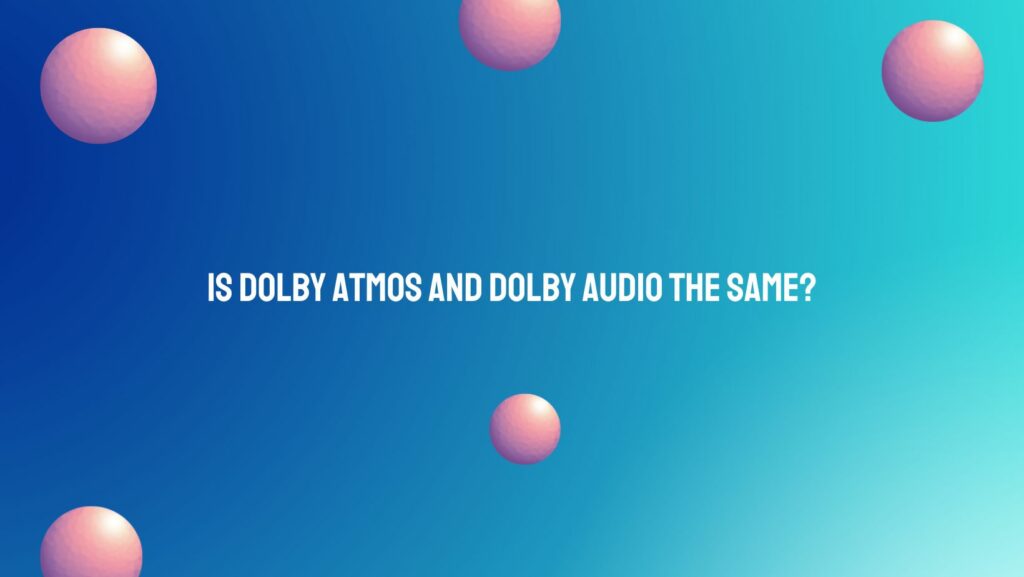In the realm of audio technology, Dolby has been a pioneering force, shaping the way we experience sound in various entertainment mediums. Amidst the plethora of Dolby offerings, two terms often surface: Dolby Atmos and Dolby Audio. Are they interchangeable, or do they represent distinct audio experiences? This article endeavors to shed light on the differences between Dolby Atmos and Dolby Audio, exploring their unique features and the scenarios in which they excel.
Dolby Atmos: A Three-Dimensional Sonic Odyssey
Dolby Atmos is a revolutionary audio technology that transcends traditional surround sound systems. Unlike conventional setups that rely on channel-based audio, Dolby Atmos introduces object-based audio. This allows sounds to be treated as distinct objects, moving freely in a three-dimensional space around the listener. The hallmark of Dolby Atmos is its incorporation of height channels, enabling audio to not only surround but also move above and around the audience. Whether in a home theater, cinema, or gaming environment, Dolby Atmos delivers an immersive and lifelike auditory experience that goes beyond the limitations of traditional audio formats.
Key Features of Dolby Atmos:
- Object-Based Audio: Dolby Atmos treats sounds as individual objects, allowing for precise placement and movement within the audio space.
- Height Channels: The inclusion of height channels introduces a vertical dimension, enhancing the immersive qualities of the audio experience.
- Adaptability: Dolby Atmos adapts to various speaker configurations, including upward-firing technology, soundbars, and headphones, providing versatility across different setups.
- Spatial Precision: The technology allows for a more accurate representation of sound placement, contributing to a realistic and dynamic auditory experience.
- Content Creation: Dolby Atmos extends its influence to content creation, enabling creators to utilize object-based mixing for movies, music, and gaming.
Dolby Audio: A Comprehensive Audio Ecosystem
Dolby Audio serves as a broader umbrella term encompassing various audio technologies developed by Dolby Laboratories. It includes a range of solutions designed to enhance audio quality and provide a superior listening experience across different devices and applications. While Dolby Atmos is a part of the Dolby Audio suite, Dolby Audio encompasses other technologies like Dolby Digital, Dolby TrueHD, and Dolby Digital Plus. Dolby Audio aims to optimize audio playback across diverse content types and playback devices, ensuring a high-quality audio experience irrespective of the source.
Key Features of Dolby Audio:
- Versatility: Dolby Audio caters to a wide range of content, from streaming services and broadcast to Blu-ray discs and gaming.
- Compression Technologies: Dolby Audio includes various compression technologies like Dolby Digital and Dolby Digital Plus, allowing for efficient storage and transmission of audio content.
- Enhanced Audio Quality: By incorporating advanced audio processing algorithms, Dolby Audio enhances the clarity, richness, and fidelity of sound across different devices.
Distinguishing Factors: Dolby Atmos vs. Dolby Audio
While Dolby Atmos is a specific and advanced audio technology, Dolby Audio serves as a comprehensive suite of audio solutions. Dolby Atmos focuses on creating a three-dimensional, object-based audio experience, emphasizing height channels for a more immersive effect. On the other hand, Dolby Audio encompasses a broader range of technologies, providing solutions for various audio scenarios beyond the immersive three-dimensional space of Dolby Atmos.
In essence, Dolby Atmos and Dolby Audio complement each other within the Dolby ecosystem, each serving a specific purpose in delivering high-quality audio experiences across different platforms and devices. Understanding their distinctions allows consumers to make informed choices based on their preferences and the nature of the content they engage with. As technology continues to evolve, both Dolby Atmos and Dolby Audio contribute to shaping the future of immersive and superior audio experiences.


